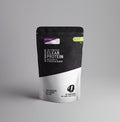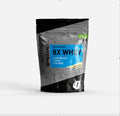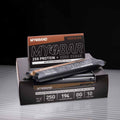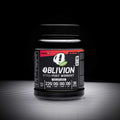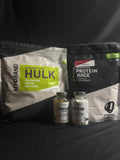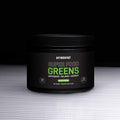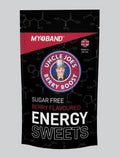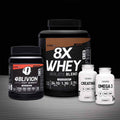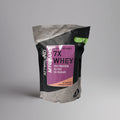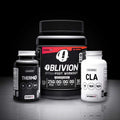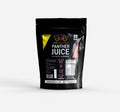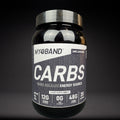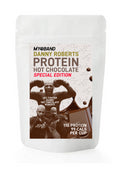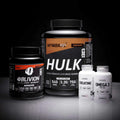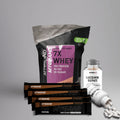Protein Powder: Why, How Much and When?
Posted by LIAM KINGSWELL

Author - Gareth Sapstead, MYOBAND Fitness Director
Here are some of the best protein-related questions we’ve been getting from you over the past month.
Q: How much protein should I have in my diet?
A: As a starting point use 1g of protein per pound of bodyweight, or 2.2g per Kilogram.
There are varying degrees of daily protein requirements recommended by scientific studies, which understandably can make things confusing:
- Helms et al. (2013) recommended 2.3-3.1g of protein per kilogram of fat-free mass (lean mass) in lean resistance-trained athletes under hypocaloric conditions (i.e., using low calorie diets).
- Phillips & Van Loon (2011) recommended 1.8-2.7g of protein per kilogram of total bodyweight, in a comparative population to the above. Similar population but different recommendations!
- The ACSM position stand suggests 1.7-2.7g per kilogram of total bodyweight in strength and endurance trained athletes.
- Wilson & Wilson (2006) recommend 1.2-2.2g per kilogram of total bodyweight for strength training athletes.
As a rule of thumb use slightly less protein (around 0.8-1.2g/kg/day) if you have a higher energy intake throughout the day, not involved in a progressive and intense resistance exercise programme, have higher levels of body fat, or have clinical restrictions (e.g., renal problems). Use a higher protein diet (1.4-2.7g/kg/day) if you are calorie or carbohydrate restricted, are involved in an intensive exercise programme, you have lower levels of body fat, or would like to preserve lean mass when restricting calories.
Q: What things can change how much protein I need?
A: Some of the main factors that affect how much protein you should have include:
- Are you surviving or are you thriving?! If you want to optimize training adaptations and thrive then your protein intake should be higher. During intense periods of training or dieting protein should be higher, whereas during maintenance phases of training, intake should be closer to the lower end of what’s recommended.
- If you are training to drop body fat, contrary to belief you should actually consume a higher amount (or at least the same amount) of daily protein versus if you were trying to gain strength and muscle mass.
- Endurance athletes should strive to stay at a low bodyweight so as their strength/power to bodyweight ratio is maximized and their movement economy is improved. When trying to maintain the same bodyweight endurance athletes should have around 1.5g – 1.8g of protein per kg of total bodyweight per day if looking to improve recovery and enhance training adaptations. If an increase in lean mass is desired, however, then consuming protein at 2g per kg or higher each day is suggested.
- If your current levels of muscle mass/lean mass are higher then an increased dosage of protein is recommended throughout the day. Helms et al. (2013) suggests 2.3-3.1g of protein per kilogram of lean mass. We don’t all have access to equipment that can identify our own levels of lean mass however, so recommendations based on total weight and a rough estimate of muscularity would be best for most. If you’d like a more accurate estimate, then seek a fitness professional that can estimate your body fat levels and lean mass through skinfold measurements (or more ‘gold standard’ methods).
- Higher levels of protein consumption are safe in most, however consider whether you have a family history, or have ever suffered from kidney issues. For these people seek the advice of a qualified medical professional before undertaking a high protein diet.
Q: When you lift weights does it break down muscle, and does protein help repair it?
A: Kind of. Here’s what really happens, keeping things as short as possible…
Before training: If nutrition and training is correct the body will be in a positive net protein balance; synthesis will be greater than breakdown. I.e., you’re building muscle when you’re resting.
During training: The body will be in a negative net protein balance; while tissue breakdown actually doesn’t increase and remains the same, synthesis of new proteins drop. Breakdown eventually exceeds synthesis as the duration of training goes on.
Post training: For a short while net protein balance will remain negative. Breakdown slightly increases at this point but in the hours to come protein synthesis rapidly rises to exceed breakdown, and to a level that exceeds pre-training. This is where adaptations are made and where it’s absolutely essential that the body is provided with the right nutrients in order to make these adaptations happen, and maximise the effectiveness of the training session.
Q: Do post-workout protein shakes actually work?
A: Yes, here’s why...
During a typical training session the body will be in a negative net protein balance; as synthesis of new proteins grinds to a halt, protein breakdown increases as the duration of the workout gets longer. After training muscle protein synthesis eventually increases and breakdown reduces, creating a positive nitrogen balance.
Using protein and supplying your body with the amino acids that it needs around these key times is vital in helping to increase muscle protein synthesis as well as decrease protein breakdown. Because of this, a higher net protein balance can be achieved, and help to promote gains in lean muscle mass, strength and muscle recovery.
Q: How long is the post-workout “anabolic window of opportunity”, and how long after my workout do I have to drink my protein shake??
A: Truth is nobody actually knows.
Numerous research has shown that adequate protein intake in the post-workout “window” is vital for optimizing muscle protein synthesis, protein breakdown, creating a positive net protein balance, repairing damaged muscle tissue, and stimulating training adaptations. For these essential mechanisms to be activated, a number of chemical processes need to take place, and hormonal secretion plays a vital role. Both increased amino acid availability (hyperaminoacidaemia) and insulin secretion (hyperinsulinaemia) are important for maximizing the anabolic and recovery potential of muscle.
Some studies have shown there to be a post-workout anabolic wondow, however others have not. The duration of this window has also shown to be varied (if it even exists), and while some have shown 15-30 minutes as optimal, some have shown the window to last as long as 2 hours or more. To cut a story short, to make things easier just stick to having your post-workout protein source straight after your workout, just after you’ve finished or once you’ve got home. Don’t panic about “losing your gains” if you’ve forgotten your post-workout and you feel you have to set a speed record to get home just to down your shake!! Your gains aren’t going anywhere!
Q: How much protein and carbs should I have in my post-workout shake?
A: In order to increase both hyperinsulinaemia and hyperaminoacidaemia in the post-workout anabolic window, a mixture of both “fast acting” proteins and high glycaemic carbohydrate is recommended. Some of the most conclusive evidence suggests that a 2/1 to 3/1 ratio of carbohydrate/protein is most effective for recovery, using anywhere between 20-30g of protein with 40-90g carbohydrate. However, some fairly recent evidence suggests that in order to “spike” insulin levels to the same degree as having that post-workout hit of carbohydrate; having 50g of fast acting protein achieves around the same effect.
Really you just need to consider whether carbohydrates fit within your current nutritional approach, and how much. If you’re looking to build muscle and get lean then I would suggest around 50-60g of good quality protein within 30 minutes of your training session finishing.
Example Post-workout recovery and muscle-building shake:
20-50g 8X Whey
40-100g CARBS
3-5g Creatine
Q: Should I have a protein shake before and during my workout?
A: Some research points to YES!
During a typical exercise session a net loss of muscle protein actually occurs, because protein synthesis is either decreased or unchanged, whereas protein breakdown is generally considered to be elevated.
Increased levels of amino acids within the blood from ingestion of amino acids before or during exercise, as opposed to after exercise, may counter the net loss of muscle protein.
Simply, less tissue breakdown may occur and hence create a more anabolic environment. Therefore a combination of amino acids like those provided in Oblivion Protein Juice can be consumed in order to increase amino acid availability, and carbohydrates to stimulate insulin release pre-workout. During your workouts there’s also a non-insulin mediated transport of amino acids around your body due to muscle contraction and blood. If you’re using an intra-workout protein strategy then you won’t need a post-workout shake. Just go for a solid meal within the few hours to finish.
Q: What type of protein powder is best for day-to-day use?
A: We recommend whey protein as a daily staple due to its high quality and complete supply of amino acids. Here’s a quick breakdown of each type:
Whey concentrate: Typically contains the lowest percentage of protein per 100g. This is due to concentrate undergoing less processing to produce the end product. A good quality whey concentrate should contain 75% protein per serving. Several bioactive fractions of whey concentrate contribute to its immune boosting potential including beta-lactoglobulin, alpha- lactalbumin, glycomacropeptide and lactoferrin. Whey concentrate has also been shown to increase the body’s production of glutathione, an extremely potent antioxidant sometimes referred to as the body’s’ ‘master’ antioxidant!
Whey isolate: Contains a larger percentage of protein per serving. It’s produced when whey concentrate is further processed and purified using techniques such as crossflow micro-filtration, ultra-filtration, reverse osmosis, or nano filtration. The rate of absorption is typically about the same between concentrate and isolate, however isolate may be the best choice if you want the highest amount of protein per serving.
Whey hydrolysate: This is whey isolate that has been further broken down, producing smaller peptides that are rapidly absorbed into the blood stream.
It’s important to note that although some would consider whey concentrate to be the lowest quality of whey protein versus isolate and hydrolysate, whey concentrate does contain some potent immune boosting properties that would arguably make it a good addition to whey isolate as a daily powder. A blend would provide you with the protein quality and content from whey isolate, and the potential health properties in a concentrate.
TAGS:
